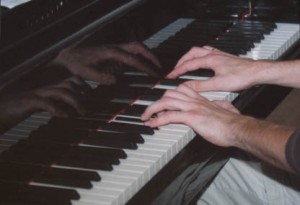First, to be absolutely clear about this, I’m not Irish. None of my parents, grandparents, or remote ancestors are from Ireland. I’ve only ever been to Ireland once, on a work trip which involved an ecumenical service to dedicate a new halal abattoir, but that’s another story.
Four years ago I decided to learn to play music, and hit on the tin whistle as my instrument of choice. It was cheap, portable, and hard to break or ruin. One thing led to another, and I found myself at traditional Irish music classes run by an organisation called Meitheal Cheoil at the Camden Irish Centre — the only place I could find where it was possible to actually have tin whistle lessons.
Within a few weeks I was beginning to pick out some traditional songs on my whistle. We learned by ear, not by reading music. This suited my musical abilities, but presented another problem; the rest of the group all knew the songs, and I didn’t.
I hadn’t really thought about this previously. I just wanted to learn an instrument, and was really taking a free ride on the Irish part. But for Methail Cheoil, the passing on and preservation of a part of Irish culture, as a live tradition rather than as a museum piece, was an essential part of the activity.
So I bought CDs, and listened to them as often as I could. There was no point in buying innovative cross-over reworking of the traditional tunes; I needed the raw stuff, so that I could get the songs into my head. To get the simplest renditions, I had to immerse myself in Hiberno-schlock, a twilight world of albums with names like ‘Twenty Irish Songs to Warm Your Heart’ and ‘Irish Party Singalong Tunes’. You’d probably recognise the Jewish equivalent if you saw it, and probably run a mile.
Of course, I did ironically, so that was OK. And there was something rather liberating about taking a dunk in someone else’s culture, and not having to worry about whether it was really politically acceptable to enjoy maudlin nationalist sentimentality. Some of the Irish members of the class worried about it rather more.
In any case, it must have worked, because by Christmas I was playing in the beginner’s band at the Irish Centre Ceilidh. And that’s where I had my revelation; anyone could be Irish if they wanted to.
Even in the whistle class, no one had seemed to find it particularly strange that I as a non-Irish person was participating in their thing. But there it wasn’t terribly clear who was and wasn’t Irish. Some of the students were first-generation immigrants — some old people reconnecting with the traditional music they’d grown up with, and some Irish yuppies for whom it was a class that they might have taken back home — but most were second or even third generation ‘assimilated’ Irish, on a roots thing. They didn’t sound or look that different from me, a third-generation descendant of Jewish immigrants.
But the Ceilidh, which included people from the other music classes and from the broader Irish community, was a whole new experience. Irishness, at least in its North London manifestation, was clearly a much more inclusive category than I had been prepared for. There were quite a few Black Irish people, and one or two Chinese ones. There were a couple of others with what looked to me like Jewish faces, though they might equally have been Greek.
I don’t know how everyone in the room felt about this; but I do know that there was no outward sign that anybody had any feelings about it at all. Then and subsequently, I have never come across any handwringing about who the traditional music activities ought to be for, let alone ‘who is an Irish person?’ The activity was Irish in content, and that was enough. Other, non-Irish people’s participation did not detract from its Irishness or threaten its existence or value.
In our community, interest by others in our culture is rarely taken at face value. Although discussions about Jewish culture are often shot through with barely-veiled assumptions about cultural superiority, we are usually suspicious about anyone else wanting to partake. Perhaps it’s because we are afraid that it won’t stand up to much scrutiny from anyone without a sentimental attachment to it; or maybe we are worried that they are only showing an interest so that they can insinuate themselves into our superior institutions. Why else would non-Jews be trying to sneak into our schools?
Either way, there is an all-pervasive obsession with maintaining and policing a boundary, with determining who is and isn’t entitled to come in. Look at the selection processes associated with admission to Jewish schools, or the application forms for joining a synagogue. No-one at Meitheal Cheoil ever asked me for my parents’ marriage certificate.
I don’t want to imply that Irish culture is inherently inclusive and anti-racist. I’m sure that someone else could find plenty of counter-examples, together with joyous examples of Jewish inclusiveness and syncretism. But I don’t think that the Jewish obsession with boundaries and separation, which make up an enormous proportion of our law and our lore, are merely accidental add-ons to our culture either. In biblical and talmudic Judaism, the principle of distinction and separation, and the importance of keeping things from mixing, is always imbued with a moral and theological dimension.
We are forbidden to mix meat and milk; fish and meat on the same plate; wool and linen in the same garment; and forbidden to yoke two kinds of animals to the same plough. God does not like it when we mix things, stuff, or ourselves. It’s worth remembering this next time you get into one of those discussions about the essential ethical core of Judaism.
